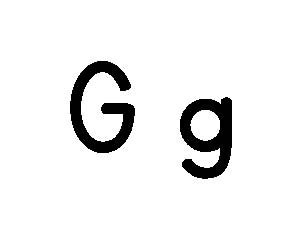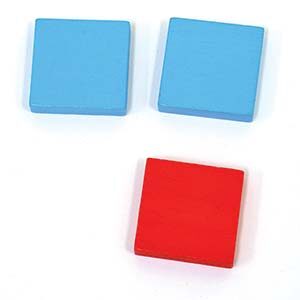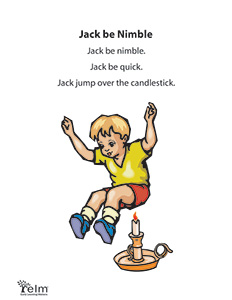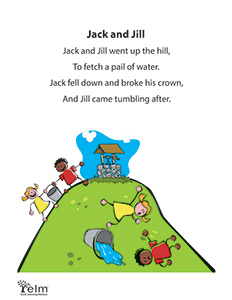Phonological awareness, Letter knowledge
Children will identify the word made by taking away the initial sound (onset) from the remaining sounds (rime). Children also will identify and name the letter G.


Review:
Today we are going to play another game with words. We will play this game by taking away a sound from a word to make a completely different word.
[Be sure to pause briefly between the two parts of each word offered below.]
Listen carefully as I say a word: /b/-all. I’ll say it again: /b/-all.
What word am I saying? (ball)
Now I will take away the beginning sound of the word “ball” to make a new word. Remember, we call the first sound we hear the beginning sound of a word. The beginning sound in the word “ball” is /b/. I will take away the /b/ sound from the word “/b/-all.” Listen to the new word: “all.” I took away the /b/ sound from the word “ball” to make the new word “all.”
Let’s try another word. Listen carefully as I say “/p/-in.”
What is the word? (pin)
Now let’s take away the beginning sound of the word “pin” to make a new word. The beginning sound is /p/.
What new word do we make when we take away the /p/ sound from the word “/p/-in”? (in)
Our new word is “in.” We took away the /p/ sound from the word “pin” to make the word “in.” Let’s try some more.
[Continue the above procedure for children to make a new word by taking away the beginning sound of a word. Offer as many of the following words as possible, depending on time and child interest. Use a mixture of ending sounds (all, in, ice) based on children’s responses.]
| Rimes | all | in | ice |
| c-all | f-in | m-ice | |
| w-all | b-in | n-ice | |
| f-all | t-in | l-ice | |
| h-all | w-in | d-ice | |
| m-all | s-in | r-ice | |
| t-all |
 Now we are going to learn a different letter of the alphabet.
Now we are going to learn a different letter of the alphabet.
[Display letter G card.]
Does anyone know the name of this letter?
This is the letter G. We can write the letter G in two ways. We can write the letter G like this.
[Demonstrate writing an uppercase G at the top of a chart paper.]
This is an uppercase G.
We can also write the letter G like this.
[Demonstrate writing a lowercase g at the top of a chart paper.]
This is a lowercase g.
We are learning about making a graph in math. We know that a graph is used to organize and present information. The word “graph” begins with the letter g. I will write the word “graph” on our chart. I am going to write “graph”with a lowercase (small letter) g.
[Say each letter as you write the word. Emphasize g.]
Let’s all say the word “graph.”
[Invite a volunteer child to point to the letter g in the word “graph.”]
Let’s look at the very first letter of our name. Pop up if you have the letter G at the beginning of your name. Remember, names begin with an uppercase (big) letter.
[Encourage children to look at their name cards. Say the first names of children who have a G at the beginning of their name. If there are children whose name begins with the letter G who do not stand, point to the letter G on their name card. Compare the letter G in their name as you hold the letter G card next to their name card.
If no one in the group has a first name beginning with the letter G, say “No one popped up because no one has a name that starts with the letter G.” Encourage children to look at the list of children’s first names. Point to some first letters of names. Explain that no one’s name begins with the letter G.
If a child indicates there is a letter G in his/her name, but not at the beginning of the name, fully recognize the name and invite the child to pop up. Day 4 gives attention to the letter g that appears somewhere else in a child’s name.]
Today we took away a sound from a word to make a completely different word.
We also learned about the letter G. What word begins with the letter g? (graph)
Extra support
Enrichment
Provide *picture cards that make a new word when the beginning sound is taken away. Examples: man, fin, dice, cup, cat, fan, hat, pan, and van. Encourage each child to choose a card and name the picture. Then invite children to say the word without the beginning sound. Adult guidance may be needed.
*Printables provided
Try today’s activity with the word family “am.” Example: Let’s take away the beginning sound of the word ‘ham’ to make a new word. The beginning sound is /h/. What new word do we make when we take away the /h/ sound from the word ‘/h/-am’? (am) Our new word is ‘am.’ We took away the /h/ sound from the word ‘ham’ to make the word ‘am.’” Try the following words: j-am, P-am, y-am, S-am, r-am.
Number knowledge
Children will count on when adding items to a group.


New:
Review:
Today we will practice making a group of blocks larger. Remember, when we add items to a group, the group gets larger.
[Organize blocks by color. Set them next to the tray.]
I have a tray and some blocks. There are two different colors of blocks: red blocks and blue blocks. I also have a die. Remember, each side of a die has a different number of dots.
[Display different sides of the die and point to the number of dots.
Place one red block on the tray.]
How many blocks are on the tray? (one)
We have a group of one red block. We will take turns rolling the die. The die will tell us how many blocks to add to our group of blocks. Remember, when the die stops rolling, we count the number of dots on the side that is facing up. The number of dots on the die will tell us how many blocks to add. We will add blue blocks.
We will count out the number of blue blocks that matches the number of dots on the die. Then we will add the blue blocks to our tray and count how many blocks we have all together. I will go first so you can see how to play.
[Roll the die and count the number of dots on the die you rolled. Say the number aloud.]
I rolled a ___. I will make a group of ___ blue blocks.
[Count aloud the number of blue blocks that matches the number of dots on the die. Place the group of blue blocks next to the one red block on the tray.]
We have two groups of blocks on our tray. One group has one red block. Our other group has ___ blue blocks.
Let’s find out how many blocks we have all together on our tray.
How can we do that? (count them all together)
 We find out the number of blocks on our tray by counting on. When we count on we start with the largest group of items and then count the number of items in the other group.
We find out the number of blocks on our tray by counting on. When we count on we start with the largest group of items and then count the number of items in the other group.
[Point to each block as you lead children in counting the blue blocks.]
How many blue blocks do we have?
Let’s begin with the number of blue blocks and count on to add our red block.
[Begin with the number of blue blocks and count on to add the red block. Example: “We have two blue blocks. We will start counting with two. 2, 3.”]
How many blocks do we have all together?
[Remove the blocks from the tray.]
Now we will try it again. Each of us can have a turn. This time let’s start with our red blocks. We can make a group of red blocks larger by adding blue blocks. Let’s roll our die for each group of blocks.
[Invite a child to roll the die.]
[If appropriate, help child create a group of red blocks by encouraging child to count each one.]
[Invite a second child to roll the die.]
[If appropriate, help child create a group of blue blocks by encouraging child to count each one.]
Let’s put the group of blue blocks on the tray.
Now we need to find out how many blocks we have all together. We will first count the largest group of blocks.
Let’s start with that number and count on to see how many blocks we have all together.
[Model counting on as you begin counting with the largest group of blocks. Example: “We have a group of four red blocks and a group of two blue blocks. We begin counting with the number four and then count on to our group of blue blocks. 4, 5, 6. We have six blocks all together!”
Repeat by beginning with zero blocks on the tray. Provide each child with a turn rolling the die and adding blocks to the tray. Encourage all children to count on. Continue as time permits.]
Today we worked with blocks and a die. We practiced adding blocks to a group. What happens to a group when we add items? (the group gets larger) We are learning how to count on. We started by counting the number of blocks in our largest group. Then what did we do? (kept counting the number of blocks in our other group)
Extra support
Enrichment
Provide materials used in today’s activity. Invite children to take turns rolling the die and adding the corresponding number of blocks to the tray.
Try this activity throughout the day with other items. Example: “Janel, I see that you are playing with two toy animals. I have three toy animals. I have a group of three toy animals, and you have a group of two toy animals. Let’s begin with my group of three toy animals and count on to see how many toy animals we have all together.”
Executive function
Children will regulate their behaviors in response to different oral and visual prompts.


Review:
Be Prepared: If time permits, offer Sleeping, Sleeping, All the Children Are Sleeping from Week 31, Day 1 as a second game. If the game described below is too challenging for a majority of children, stop at an appropriate place and offer Sleeping, Sleeping, All the Children Are Sleeping from Week 31, Day 1. The game for today may be less challenging when offered again at a later point.
Today we will play Conducting an Orchestra. This game helps us to concentrate on what we need to do.
How do we play Conducting an Orchestra?
Remember, an orchestra is a group of people who play certain kinds of musical instruments together.
What does someone do when they conduct an orchestra? (lead it)
So, when someone conducts an orchestra, they lead a group of people playing certain kinds of musical instruments.
[Give each child a musical instrument. Instruments may include drums, bells, triangles, rhythm sticks, etc. Provide children with a few moments to play their instruments.]
I will be the conductor, and you will be the orchestra. When I wave the baton slowly, we will play our instruments slowly. Then when I wave the baton quickly, we will play our instruments quickly.
What should we do when I stop waving the baton? (stop playing our instruments)
Let’s try it.
[Wave the baton slowly as children play the instruments slowly. After a few seconds, wave the baton quickly. Wait for children to begin playing quickly before you begin waving the baton slowly again. Continue for several minutes as children practice playing quickly, slowly, and stopping while watching the baton.]
Now we are going to change the game a little. This time when I wave the baton, we will stop playing our instruments. Then when I stop waving the baton, we will begin playing our instruments.
[Hold the baton still and encourage children to play their instruments. After a few seconds, begin waving the baton and encourage children to stop playing their instruments. Wait for children to stop playing their instruments before you stop waving the baton again. Continue practicing with the rule changes for several minutes.]
Today we again played Conducting an Orchestra. We changed the rules of the game.
Extra support
Enrichment
Invite children to continue playing Conducting an Orchestra. Encourage children to take turns waving the baton. Ensure the baton does not have a pointed or sharp tip. A soft stick-like item may be used as a baton.
Send the new game rules home with children and encourage them to explain the new rules to family members at pickup time. Invite families to play at home.
Knowledge of creative processes, Skills that support creative expression
Children will imitate characters in familiar nursery rhymes.


Review:

Yesterday we imitated characters in nursery rhymes. We know that imitate means to sound like or look like someone or something else. We imitated with our voices, facial expressions, and body movements. What was one of the nursery rhymes we imitated?
Today we are going to imitate characters in two more nursery rhymes. One of our nursery rhymes for today has more than one character. We can choose which character we want to imitate.
 [Display card for “Jack Be Nimble.” Read the nursery rhyme.]
[Display card for “Jack Be Nimble.” Read the nursery rhyme.]
[Encourage children to imitate Jack jumping over a candlestick as you read the rhyme again.]
Let’s listen to another nursery rhyme. This nursery rhyme has two characters in it. We can decide which character we want to imitate.
 [Display card for “Jack and Jill.” Read the nursery rhyme. Explain that “fetch” means to go get something and bring it back, and “crown” is another word for head.]
[Display card for “Jack and Jill.” Read the nursery rhyme. Explain that “fetch” means to go get something and bring it back, and “crown” is another word for head.]
Both of the characters went up the hill and both of the characters fell down. We can imitate Jack or Jill. It is your choice. All of us do not need to imitate the same character. Remember, we can use our body, facial expression, and voice when we imitate.
[Encourage each child to imitate his/her chosen character as you read and display the rhyme card.]
Today we used two nursery rhymes to practice imitating different characters.
Extra support
Enrichment
Provide several nursery rhyme books on tape. Invite children to imitate the character(s) while listening to the nursery rhymes.
Choose other familiar rhymes children like. Read or tell these rhymes to the children and invite them to imitate the characters in the rhymes.